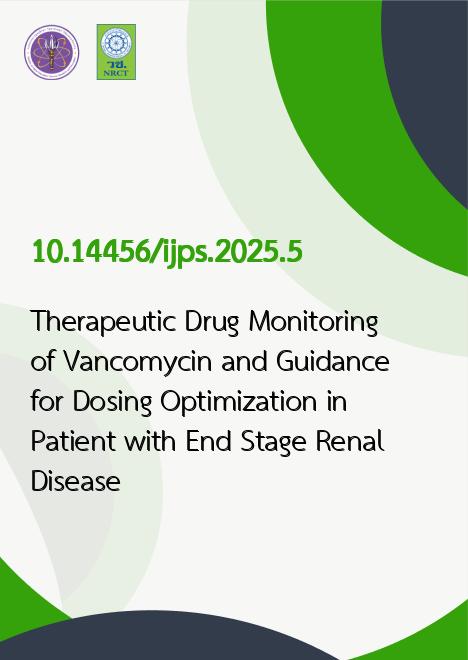
|
Therapeutic Drug Monitoring of Vancomycin and Guidance for Dosing Optimization in Patient with End Stage Renal Disease |
|---|---|
| รหัสดีโอไอ | |
| Creator | Warot Srichompu |
| Title | Therapeutic Drug Monitoring of Vancomycin and Guidance for Dosing Optimization in Patient with End Stage Renal Disease |
| Contributor | Jirayu Phuekpan, Cholatip Pongskul, Denpong Patanasethanont |
| Publisher | Faculty of Pharmaceutical Sciences KKU MSU UBU |
| Publication Year | 2568 |
| Journal Title | Isan Journal of Pharmaceutical Sciences |
| Journal Vol. | 21 |
| Journal No. | 1 |
| Page no. | 64-77 |
| Keyword | Vancomycin Dosing, Therapeutic Drug Monitoring, End-stage renal disease (ESRD), Monte Carlo Simulation |
| URL Website | https://tci-thaijo.org/index.php/IJPS |
| Website title | Isan Journal of Pharmaceutical Sciences, IJPS |
| ISSN | 19050852 |
| Abstract | Vancomycin is primarily eliminated from the body through the kidneys and exhibits pharmacokinetic variability. Due to its narrow therapeutic range, monitoring drug concentrations is essential during treatment. Impaired kidney function in end stage renal disease (ESRD) patients affects pharmacokinetics, influencing drug distribution and elimination. Currently, there is insufficient pharmacokinetic data in Thai patients with ESRD to determine appropriate dosing. Objective: This retrospective study aimed to analyze the pharmacokinetic parameters of vancomycin in ESRD patients and determine the appropriate dosage regimen of vancomycin for ESRD patients. Methods: The data of ESRD patients who used vancomycin from medical records including dosage regimen, and serum vancomycin concentrations after administration of the first dose were analyzed by using the linear pharmacokinetics of one-compartment, short infusion model equation to derive pharmacokinetic parameters. Subsequently, the trough concentrations of vancomycin were calculated based on the administered dose, and the number of patients with subtherapeutic drug levels was assessed. The patient's pharmacokinetic parameters were then used to perform a Monte Carlo simulation to determine the appropriate initial vancomycin dosing for ESRD patients. Results: Pharmacokinetic parameters of 211 ESRD patients were calculated from measured serum vancomycin concentration. Volume of distribution (Vd) was 41.42 ? 8.56 liters, elimination rate constant (Ke) was 0.017 ? 0.013 hour-1, Clearance (CL) was 0.410 ? 0.288 L/hr, and elimination half-life was 58.62 ? 52.54 hours. At 24 hours after the first dose administration, 42.7% of patients had vancomycin levels less than 15 mg/L, and 14.6 % of patients had vancomycin levels less than 10 mg/L. From Monte Carlo simulation, it revealed that the appropriate loading dose of vancomycin to achieve the trough serum concentration above 10 mg/L is 20-30 mg/kg, and 25-30 mg/kg for those who need serum concentration above 15 mg/L. Monitoring drug level should be performed within 24 hours after the loading dose to evaluate individualized pharmacokinetic parameters and design the maintenance dosage regimen. Conclusion: From this study, giving a loading dose of 25 - 30 mg/kg vancomycin, then measuring serum drug concentration at 24 hours after administration to evaluate pharmacokinetic parameters and design the appropriate individualized maintenance dose may be useful to enhance treatment efficacy and reduce the risk of drug resistance. |
